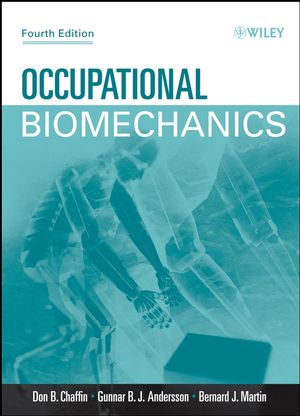|
Textbook
Occupational Biomechanics, 4th EditionISBN: 978-0-471-72343-1
Hardcover
376 pages
May 2006, ©2006
 This is a Print-on-Demand title. It will be printed specifically to fill your order. Please allow an additional 10-15 days delivery time. The book is not returnable.
|
||||||
Foreword.
Preface.
Acknowledgments.
1. Occupational Biomechanics as a Specialty.
1.1 Definition of Occupational Biomechanics.
1.2 Historical Development of Occupational Biomechanics.
1.2.1 Kinesiological Developments.
1.2.2 Developments in Biomechanical Modelling.
. 1.2.3 Developments in Anthropometry.
1.2.4 Methods for Evaluating Mechanical Work Capacity.
1.2.5 Developments in Bioinstrumentation.
1.2.6 Developments in Motion Classification and Time Prediction Systems.
1.3 The Need for an Occupational Biomechanics Specialty.
1.3.1 Epidemiological Support for Occupational Biomechanics.
1.3.2 Social and Legal Support for Occupational Biomechanics.
1.3.3 Ergonomic Support for Occupational Biomechanics.
1.4 Who Uses Occupational Biomechanics?.
1.5 Organization of The Book.
Review Questions.
References.
2. The Structure and Function of the Musculoskeletal System.
2.1 Introduction.
2.2 Connective Tissue.
2.2.1 Ligaments, Tendons, and Fascia.
2.2.2 Cartilage.
2.2.3 Bone.
2.3 Skeletal Muscle.
2.3.1 The Structure of Muscles.
2.3.2 The Molecular Basis of Muscle Contraction.
2.3.3 The Energy Metabolism of Muscle.
2.3.4 The Nerve Impulse Causing Muscle Contraction.
2.3.5 Mechanical Aspects of Muscle Contraction.
2.3.6 Muscle Fatigue.
2.3.7 Quantification and Prediction of Fatigue.
2.4 Joints.
2.4.1 The Synovial Joint.
2.4.2 Joint Lubrication.
2.4.3 Osteoarthritis.
2.4.4 Intervertebral Discs.
Review Questions.
References.
3. Anthropometry in Occupational Biomechanics.
3.1 Measurement of Physical Properties of Body Segments.
3.1.1 Body-Segment Link Length Measurement Methods.
3.1.2 Body-Segment Volume and Weight.
3.1.3 Body-Segment Locations of Center of Mass. Normal Ranges Joint Center



